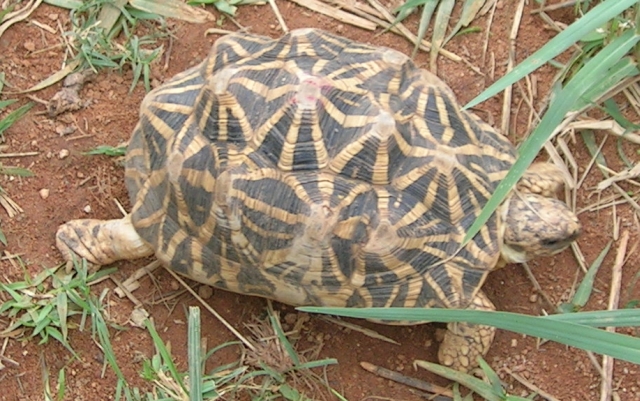Indian Star Tortoise
From Wikipedia, the free encyclopedia
[Photo] Star tortoise, Geochelone elegans. Date: 24 June 2006. Author L. Shyamal
The Indian Star Tortoise (Geochelone elegans) is a species of tortoise found in dry areas and scrub forest in India and Sri Lanka (Ceylon) . This species is quite popular in the exotic pet trade.
Description
Carapace very convex, dorsal shields often forming humps; lateral margins nearly vertical; posterior margin somewhat expanded and strongly serrated; no nuchal; supracaudal undivided, incurved in the male; shields strongly striated concentrically; first vertebral longer than broad, the others broader than long, third at least as broad as the corresponding costal. Plastron large, truncated or openly notched in front, deeply notched, bifid behind; suture between the humerals much longer than that between the femorals; suture between the pectorals very short; axillary and inguinal rather small. Head moderate; forehead swollen, convex, and covered with rather small and irregular shields; beak feebly hooked, bi- or tricuspid; edge of jaws denticulated; alveolar ridge of upper jaw strong. Outer-anterior face of fore limb with numerous unequal-sized, large, imbricate, bony, pointed tubercles; heel with large, more or less spur-like tubercles; a group of large conical or subconical tubercles on the hinder side of the thigh. Carapace black, with yellow areolae from which yellow streaks radiate; these streaks usually narrow and very numerous: plastron likewise with black and yellow radiating streaks. Length of shell 10 inches. [1]
The patterning although highly contrasting is disruptive and breaks the outline of the tortoise as it sits in the shade of grass or vegetation. They are mostly herbivorous and feed on grasses, fallen fruit, flowers and leaves of succulent plants, and will occasionally eat carrion.
The sexual dimorphism of adult Indian Star Tortoises is quite apparent. Females are considerably larger than their male counterparts. In addition, the females plastron is much flatter than that of the males which has a concave shape.
Distribution
India (except Lower Bengal), extending west to Sind: and Ceylon.
Captivity and trade
Raising these animals in captivity is extremely difficult and should be left to those with advanced tortoise experience. They are very finicky eaters and gain weight extremely slowly. Hatchlings would rather sleep than eat and most succomb in the first months of life. A typical hatchling in the United States costs about $500 from a reputable dealer and you should be prepared to lose this investment if you do not have significant experience with tortoise. It is best to have a close relationship with a veterinarian who has experience with tortoise care.
A large number of specimens of this species are found in the illegal wildlife trade in India. Few studies exist which have quantified wild populations and the effect of trade on them.
http://en.wikipedia.org/wiki/Indian_Star_Tortoise
| The text in this page is based on the copyrighted Wikipedia article shown in above URL. It is used under the GNU Free Documentation License. You may redistribute it, verbatim or modified, providing that you comply with the terms of the GFDL. |
|

